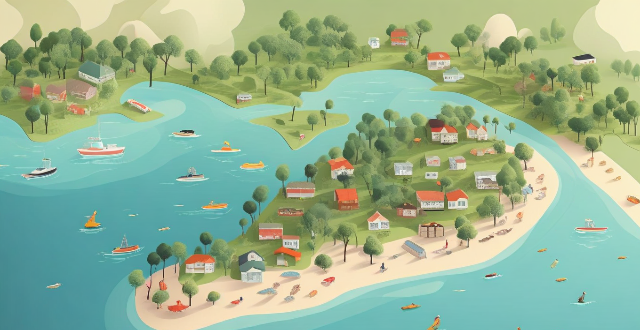The provided text discusses the various impacts of climate change on coastal areas and small island nations, including increased erosion, displacement of communities, changes in marine ecosystems, extreme weather events, economic impacts, and adaptation challenges. It highlights how these impacts can lead to loss of land area, damage to infrastructure, cultural loss, degradation of coral reefs, habitat loss for marine life, more intense storms, changes in precipitation patterns, threats to the tourism industry, decline in fisheries, limited resources for adaptation measures, and vulnerability of certain populations to health risks and food insecurity.

Impacts of Climate Change on Coastal Areas and Small Island Nations
Sea Level Rise
Increased Erosion and Coastal Flooding
- Erosion: As sea levels rise, the force of waves on shorelines increases, leading to more rapid erosion of beaches and cliffs. This can result in loss of land area and damage to infrastructure.
- Flooding: Higher sea levels also mean that tidal floods and storm surges reach further inland, affecting low-lying areas and causing saltwater intrusion into freshwater sources.
Displacement of Communities
- Relocation: Permanent or temporary relocation may be necessary for communities facing severe flooding or whose land is no longer habitable due to erosion.
- Cultural Loss: The displacement of people can lead to the loss of cultural heritage sites and traditional ways of life for coastal and island communities.
Changes in Marine Ecosystems
Coral Reef Degradation
- Temperature Stress: Warmer ocean temperatures can cause coral bleaching, where coral expels its symbiotic algae, turning white and becoming more susceptible to disease.
- Acidification: Ocean acidification, caused by increased carbon dioxide absorption, makes it harder for corals and other marine organisms to build their calcium carbonate structures.
Habitat Loss for Marine Life
- Mangrove Death: Rising sea levels can drown mangrove forests, which are vital habitats for many fish species.
- Seagrass Decline: Reduced water quality and changes in temperature and light levels can harm seagrass beds, another important ecosystem for marine biodiversity.
Extreme Weather Events
Intensified Storms
- Hurricanes and Typhoons: Warmer sea surface temperatures can lead to more intense hurricanes and typhoons, posing a greater threat to coastal regions and small islands.
- Wind Speeds: Increased wind speeds associated with these storms can cause additional damage to buildings, crops, and natural habitats.
Changes in Precipitation Patterns
- Droughts: Some areas may experience prolonged periods without rain, affecting agriculture and freshwater supplies.
- Heavy Rainfall: Other regions might see an increase in heavy downpours, leading to flash flooding and soil erosion.
Economic Impacts
Tourism Industry Threats
- Environmental Degradation: A decline in natural beauty and recreational activities like diving or fishing can reduce tourism revenue for coastal nations.
- Infrastructure Damage: Frequent extreme weather events can damage hotels, airports, and other key tourism infrastructure.
Fisheries Decline
- Overfishing: As fish stocks move due to changing temperatures, local fisheries may struggle, leading to economic hardship for fishing communities.
- Habitat Loss: The loss of essential fish habitats like mangroves and seagrass beds can further reduce fish populations.
Adaptation Challenges
Limited Resources
- Financial Constraints: Many small island nations have limited financial resources to invest in adaptation measures such as seawalls or climate-resilient infrastructure.
- Technology Gap: Access to advanced technologies that could mitigate some effects of climate change might be restricted due to cost or availability.
Vulnerable Populations
- Health Risks: Changes in temperature and extreme weather events can exacerbate health issues, particularly among the elderly, children, and those with pre-existing conditions.
- Food Security: Climate change impacts on agriculture and fishing threaten food security for residents of coastal areas and small islands who rely on these sectors for sustenance.